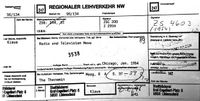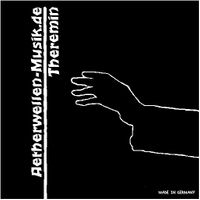Re-inventing Lev's Theremins - A straining journey into sound or “How I learned to stop worrying and love the … Theremin”
I think I first saw a Theremin in a b/w Jerry Lewis movie on television as I was a child, but forgot about it. Around 1995, I watched the documentation about Leon Theremin: “Theremin - An Electronic Odyssey” (1993) in German television which started my journey about the Theremin - likely because the shown instruments were tube based and I had collected and repaired tube radios and tube TV-sets since I was a boy.
In 1997 I took part in a local TV show (WDR Lokalzeit Südwestfalen), presenting some of my collected items as can be seen in the video.
In 1995 the internet was not available to me and hardly known, so I tried to find Theremin information from libraries and books. But while based in Germany, there was only little information to find.
Later, I discovered that in the early 1930’s Leon Theremin and a German company planned to manufacture and sell Theremins. Sadly, these plans have not come to reality because of the rising Nazi regime and the Jewish ownership of the company. Theremin then went to America and RCA produced a limited amount of Theremin instruments.
In contradiction to RCA’s advertisements, the instrument was hard to manufacture, costly and extremely hard to play. Another problem was instable tuning, limited pitch and slow volume control response. Some of this disadvantages have been caused by the materials, components and tubes of that time 90 years ago. Nevertheless, some disadvantages are caused by functional principles and are therefore inherent to the instrument. These just can be reduced but not eliminated completely. External disturbance effects are for instance changing ground connections, electromagnetic and capacitive RF and LF fields (switching power-supplies, mobile phones, TV-sets, transformers, power-LAN).
I played the accordion quite well for a couple of years, but I wouldn’t describe myself as a musician; but as technician I would say I have some musical tone feeling and knowledge which is important to construct and maintain music electronics and especially Theremins. As with each music instrument, the player and musician must have some knowledge about the function of his instrument. At least as much to adjust it and perform simple repairs. The information provided here may serve as a guide to achieve this goal.
I will focus on Theremin instruments which can be build without components like specialized integrated circuits and special commercial coils. All circuits and mechanical constructions may be improved by yourself. It is important that general principles are understood to construct, maintain and play a Theremin. There will be no detailed information given, e.g. part lists and already worked out circuit boards, because the interested builder shall switch on his brain himself - to learn and understand. This is the main intention, to enable people to realize their own ideas, guided by the given information.
Research for more than ten years now leads me to the assumption, that most of the functional principles of the Theremin are just understood by musicians and even Theremin builders and engineers up to a certain level. So I'll focus mainly on the electronics and technical principles which influence the proper function of a Theremin. Information given is intended to serve as a guide to the world of Theremin related electronics.
In general, one can describe Lev's Theremin circuit (of the Rockmore/Rosen instruments) as a pitch and volume dependent pulse-width modulator, applying beat frequency principles. The pulse width dependency of the audio spectrum of musical instruments, especially of wind-instruments, was already described by K. E. Schumann “Physik der Klangfarben: Klangfarbengesetze” (Physics of Timbres: Sound Colour Laws) in 1929 and implemented to the German Wood-Wind-Synthesizer “Variophon” by the Realton company in the 1980s. Luckily, I accidentally found a so called “Variophon Standard” at a junk-sale in Frankfurt am Main, Germany, a few years ago. The Variophon has fixed pitches and appropriate pulse-widths (played by pressing keys), contrary to the Theremin, in which the pitch and the pulse-widths are continuous.
At the Theremin, pitch and volume are of course controlled by the free movement of the player's hands in space, varying the distance to the pitch- and volume antennas. Due to the audio feedback process, there has to be no noticeable delay of the pitch response – this is an important issue. This is why the player's monitoring speaker has to be placed at the height of his head close behind him. Today, headphones can be used – but due to the mayor influence of the speaker to the sound quality, the speaker’s signal shall be miked and lead to the headphones to maintain the original sound impression.
For engineering people, who are used to develop the precision electronics used today and had undergone the common studies and education, it is quite difficult to get the feeling for musical devices and especially for electronic sound creation. That's why some seem to think all can be done by sound-sampling techniques. Leon Theremin has produced pleasing, naturalistic sound with minimalistic circuitry a century ago. This must be the ideal to achieve. Of course, when applying the principles Theremin invented correctly, a complete digital approach (e.g. using fast real-time processing by FPGA) is possible.
Because of limited engineering empathy – and probably purely commercially reasons, Theremin literature, focusing on the instrument's sound creation process is still fragmentary up till today.
I'll try to clarify some of the essential things I (re-) discovered during my journey into sound. I think there have been many misleading approaches made during the last hundred years, already starting shortly after the introduction of the Theremin in the nineteen-twentieths. This was due to misinterpretation or while trying to apply already known radio set circuitry to the Theremin which was not the best approach for a musical instrument.
The Theremin is not and will never be a simple beat frequency oscillator, producing sine-waves. It is a pitch and volume dependent pulse-width modulator, witch's pulse-with behavior can be adjusted e.g. to produce the characteristic audio spectrum of the well known Rockmore-Theremin. Of course, the playing technique has a big influence to the sound, but the basic sound and its manipulation facilities have already to be built within the instrument itself!
Dipl. Ing. A. Klaus, Darmstadt, Germany

